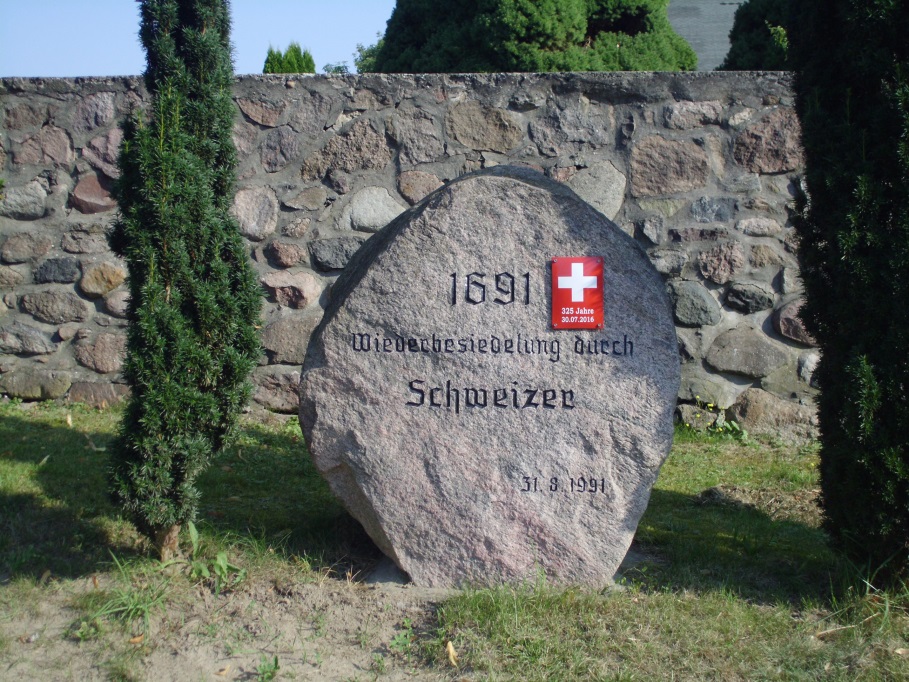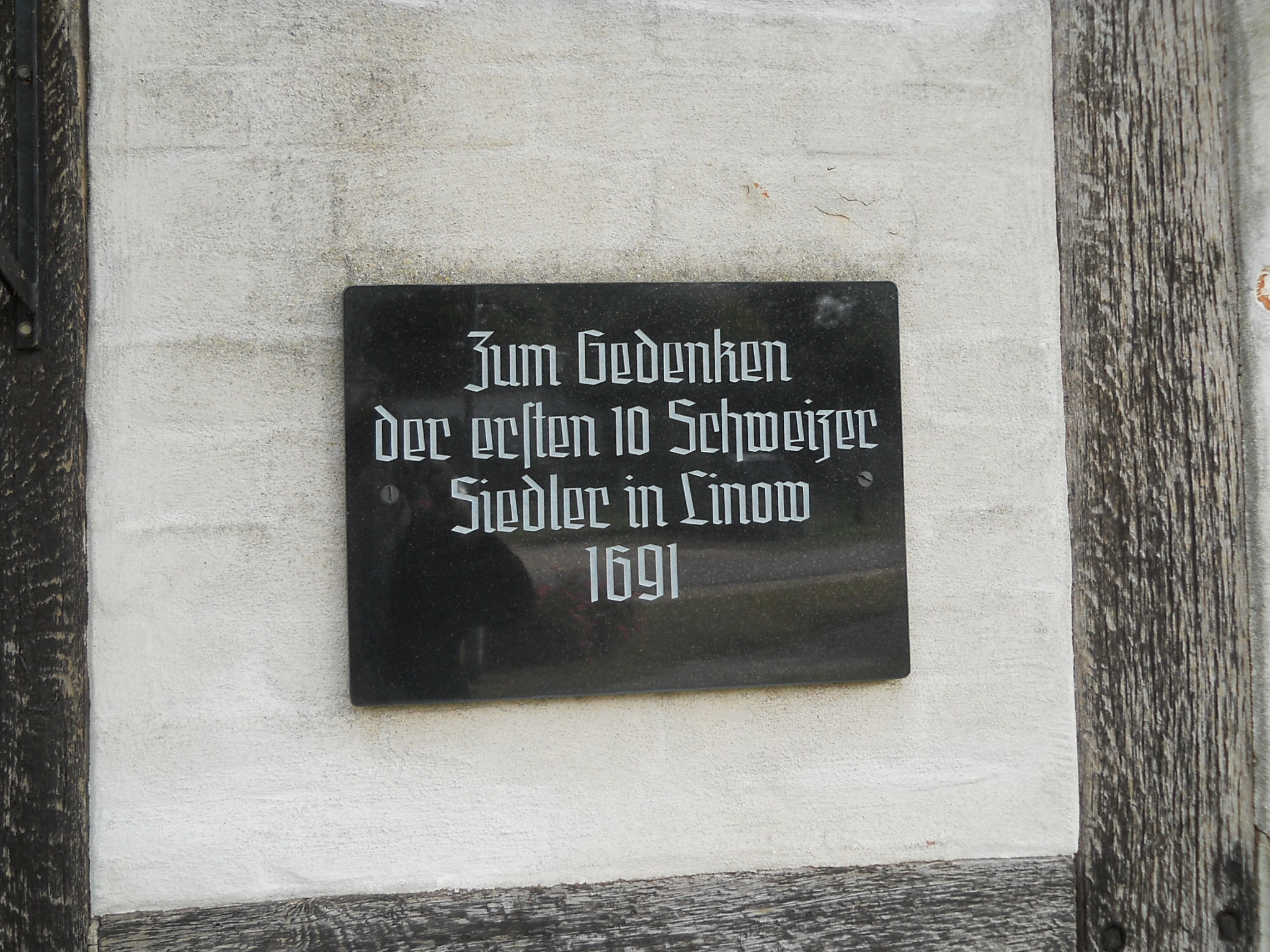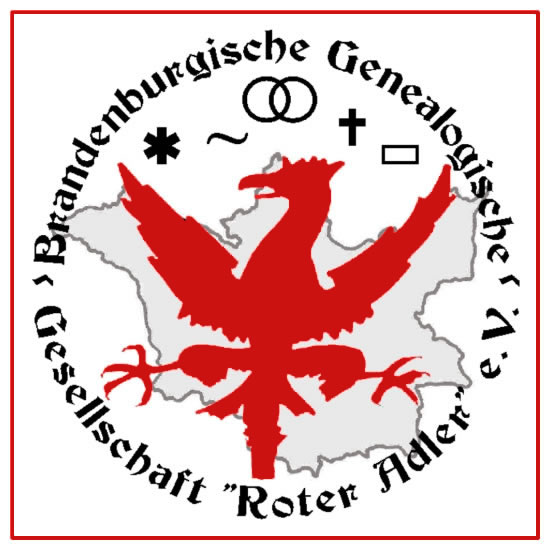Research group “Colonists from Switzerland in Brandenburg from 1685”
Coordinator: Aldo Hoffer
For some families in Brandenburg, the legend of having Swiss ancestors is part of family history—as seen in names such as Garmatter, Durtschy, Lüthy, Suter, or Pfister. But what about names like Müller, Schneider, Moser, Scherler, or Hoffer? It is possible, especially in the area of Ruppin, that a person researching their family comes across proof of ancestry in the Swiss colonists.
This page is intended to provide references to sources in literature, archives, and databases as well as serve to assist in the research of the settling and expansion of colonists from Switzerland in Brandenburg starting in 1685. Questions regarding this topic and regarding particular families can be directed toward the coordinator of the group “Schweizer Kolonisten in Brandenburg” (Swiss Colonists in Brandenburg”) in the BGG Roter Adler, namely Aldo Hoffer.
 |  |
| Figure 1: Memorial stone in the cemetery in Schulzendorf (2017) Photo: A. Hoffer | Figure 2: Memorial plaque at the village church in Linow (2017) Photo: A. Hoffer |
Emigration and settlement
The history of the targeted recruitment and settlement in Brandenburg of colonists from Switzerland began more than 325 years ago. Following the Thirty Years’ War, many districts were ravaged. The Elector of Brandenburg was looking for colonists in order to revive the villages and cities, and so he sent petitions to e.g. Bern in order to solicit interested settlers. Apart from gaining new subjects, the Elector of Brandenburg saw in these Swiss subjects particular confessional advantages since they were of the Reformed faith. The first fourteen Swiss settlers were allocated land in 1685 in Golmer Bruch near Potsdam. They were given extensive privileges, which in the beginning could even be inherited. Further colonist settlements with settlers from the cantons Bern and Zurich were formed in 1691/1692 in Ruppiner Land on individual estates and deserted villages near Neuruppin, Rheinsberg, and Lindow. These included Vilitz, Glambeck, Storbeck, Schulzendorf, Lüdersdorf, Linow, and Klosterheide. Colonists were also settled near Lehnin. Some of the colonies were incorporated into existing villages, but because of differences between locals and settlers this proved to be more difficult than life in settlers-only villages. Only Swiss Reformed preachers were allowed to preach in the Reformed churches of the Swiss settlers. Many of the privileges were slowly taken away, and some colonists even retreated back to their homeland. In total, around 2200 Swiss settlers were brought in.
The families of these Swiss settlers quickly expanded and new farmsteads needed to be created. They spread themselves out to new places or new colonies in Brandenburg. Some of the colonists or their sons moved to East Prussia around 1711, and later to the eastern reaches of Oderbruch. For example, in the baptismal records of the East Prussian town Sadweitschen there are records of relatives of colonists’ families from Nattwerder (Golmer Bruch).
Literature regarding colonization
The history of the Swiss settlers has been depicted several times and in varying depth in the past. The first detailed and comprehensive publications in Germany were the articles by Erich Wentscher appearing in the 1930s, titled Die Schweizer Kolonien in der Mark Brandenburg1 as well as by Franz Moser, titled Die große Berner Auswanderung nach Brandenburg im Jahre 1691.2 More recently, there are the comprehensive books Neusiedler im verheerten Land – Die Mark Brandenburg nach den Kriegen des 17. Jahrhunderts3 by Matthias Asche Schweizer Kolonisten in der Kurmark Brandenburg im 17./18. Jahrhundert by Ulrich Schmelz4.
Some family researchers have published their research results; among them is Waltraut Thurmann regarding Aschebach5 and Pfister6 in Hohenbruch, as well as Karl-Ernst Friederich regarding Lüthy in Lüdersdorf (Altlüdersdorf) and Vielitz.7 Particularly rich material for the topic of Swiss colonists in Brandenburg was arduously collected in the manner of a detective’s detail work by Klaus Scherler, well-known in research circles and in 2012 deceased much too early. He unfortunately never published the comprehensive overview that he created. He researched for decades in literature, archives, transcripts and church books of the Lutheran and Reformed churches in Brandenburg and Berlin. He compiled an extensive directory of literature and data sources which is the most important guide to researching Swiss colonists. In his article Schweizer Kolonisten in Brandenburg – Vorstellung einer Datensammlung 8 he describes his methodology and points out possible research aids. His overview of church book records are in the form of a source registry; in other words, they provide not the detailed individual record, but rather where he found it with place name, year, and type of registry. For archived records he used the complete text. He leaves it to the individual researcher to put together their own family history with data, assessment, and correlations. Due to the fact that his data collection is in private hands, questions regarding his research compilations can be only be handled individually.
Internet sources
Until recently the only way to research our ancestors was by making our way into the archives and parish offices. But today we have the possiblity to do our research online. Important sources are often the church books and registry office records which have been digitalized, available from various platforms which are either free or paid-access. For the topic of Swiss colonists, the Brandenburg Church Book Duplicates 1804–1874 are particularly important (Brandenburgischen Kirchenbuchduplikate 1804–1874). In February 2017, the church books of all congregations in Bern were made available online by the state archive of the canton Bern. The state archive of St. Gallen are also online.
Historical memory – regional memory
How can we preserve the knowledge about the origin of the Swiss colonists today? In the past, written publications about the historical events were often published in conjunction with big anniversaries. Local chroniclers provided reviews among other things about the settlement of Golmer Bruch9, and in particular Nattwerder10, Storbeck11 and Schulzendorf12.
As the first place of colonization, Nattwerder has an active group called “Swiss Colonist Village Nattwerder” (Schweizer Kolonistendorf Nattwerder). Based on its website, it appears to have about 25 members who have made it their task to preserve the historical and cultural inheritance of the unique little settlement. Thanks to them, historical graves have been restored and the old church renovated.
In 1991, many places in Ruppiner Land celebrated the 300th anniversary of the Swiss colonization. A memorial stone was erected in Schulzendorf (figure 1). A memorial plaque was erected at the church entrance in Linow (figure 2).
Colonists are also remembered in parades and pageants, such as in Vileitz in 2014.13 In 2016, various towns celebrated the 325th annivesary of the Swiss colonization. In Schulzendorf14 and Linow15 there were even representatives from the Swiss embassy present at the celebrations. Storbeck also celebrated the 325th anniversary.16 The BGG “Roter Adler” also took up the topic in 2016 with a talk by Matthias Asche at the “11th Regional Meeting in Brandenburg for Homeland and Genealogy.”17.
1 Wentscher, Erich: Die Schweizer Kolonien in der Mark Brandenburg.
In: Archiv für Sippenforschung 7 (1930), S. 238–244, 291–294, 388–391 und 429–432.
2 Moser, Franz: Die große Berner Auswanderung nach Brandenburg 1691.
In: Archiv für Sippenforschung 5 (1937), S. 143f., 173–177 und 215–217.
3 Asche, Matthias: Neusiedler im verheerten Land. Aschendorf, Münster 2006.
4 Schmelz, Ulrich: Schweizer Kolonisten in der Kurmark Brandenburg im 17./18. Jahrhundert.
In: Kletzin, Birgit (Hg.): Fremde in Brandenburg. Münster u. a. 2003, S. 48–69.
5 Thurmann, Waltraut: Die Aschebachs aus Hohenbruch.
In: Familienforschung in Mitteldeutschland 37 (1996), S. 332–335
6 Thurmann, Waltraut: Die Pfisters aus Hohenbruch.
In: Familienforschung in Mitteldeutschland 38 (1997), S. 166–170
7 Friederich, Karl-Ernst: Die Schweizer Familie Lüthy in Brandenburg.
In: Brandenburgische Genealogische Nachrichten 4 (2014), S. 180–182
8 Scherler, Klaus: Schweizer Kolonisten in Brandenburg – Vorstellung einer Datensammlung.
In: Brandenburgische Genealogische Nachrichten 4 (2014), S. 46–65
9 Heese, Henning (Hrsg.): 300 Jahre Schweizer Kolonie am Golmischen Bruch bei Potsdam 1685–1985. St. Augustin 1985. Hierin Beiträge von Jochen Dortschy, Gerhard Heese-Golm und Alfred Hans Kuby
10 Bleyl, Dietmar (Hrsg.): 1685–2010 Nattwerder – 325 Jahre Besiedlung des Golmer Bruchs (1685–2010). Schweizer Kolonistendorf Nattwerder (2010)
11 Stirnemann, Heinz: Woselbst sie wohl aufgenommen – 300 Jahre Schweizer Kolonien in der Mark Brandenburg am Beispiel der Gemeinde Storbeck. Frankfurt am Main 1991
12 Dräger, Carsten: Schulzendorf 1691–1991. Von den Anfängen bis zur Gegenwart. Festschrift der Gemeinde Schulzendorf.
13 Jahrbuch Ostprignitz-Ruppin 2016, Geschichte und Geschichten, Drebenstedt, Marga und Noll, Helmut: Vielitz – aus der Geschichte eines Bauerndorfes im Ruppiner Land, S. 130–155, hier S. 152–153.
14 Hoher Besuch zum Dorffest in Schulzendorf: http://www.moz.de/artikel-ansicht/dg/0/1/1488355, Artikel vom 6. Juni 2016; abgerufen am 26. März 2017.
15 Das ganze Dorf war auf den Beinen: http://www.moz.de/artikel-ansicht/dg/0/1/1510861, Artikel vom 28. August 2016; abgerufen am 26. März 2017.
16 Storbecker feiern 325-jähriges Bestehen. http://www.maz-online.de/Lokales/Ostprignitz-Ruppin/Storbecker-feiern-325-jähriges-Bestehen, Artikel vom 12. Juni 2016; abgerufen am 26. März 2017.
17 Bericht zum 11. Regionaltreffen Brandenburg für Heimat und Familiengeschichtsforscher. Brandenburgische Genealogische Nachrichten 5 (2016) S. 180 ff. 12. Jahrgang, Ausgabe 3/2017, Band VI/Heft 3.
